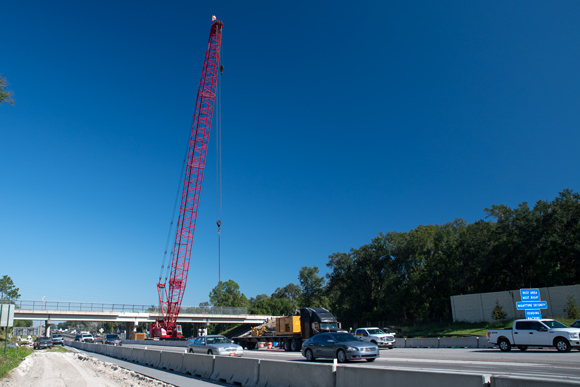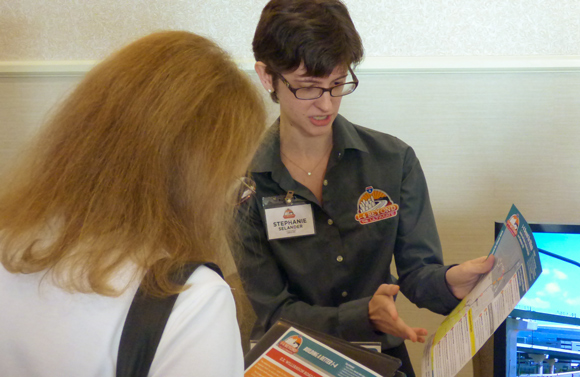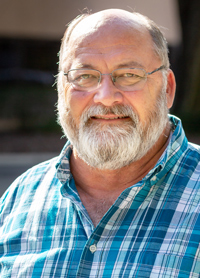Pile Driving at E.E. Williamson Road Over Interstate 4 Begins
Every large structure built as part of the I-4 Beyond the Ultimate project must have a solid foundation to support its massive bulk.
Instead of the familiar concrete-block foundation of a typical house, interstate structures rely on underground pillars made of concrete or steel — known as piles.
Piles are long, vertical structures made of steel or concrete that are placed deep into dense layers of the ground to support various structures. Piles often must be sunk as deep as 120 feet to ensure safe, stable foundations for bridges and overpasses. The only way to get those support pillars deep into the ground is by pile driving.
Pile driving is necessary for the reconstruction of the E.E. Williamson Road overpass. Pile driving began in November 2019.
Fortunately, there are techniques that can lessen the noise and vibration caused by that activity.
Construction crews drive the pile into the ground using two methods. Wherever possible — especially in areas of soft or loose soils — pilings can be “vibrated” into the ground rather than driven using a hydraulic or diesel-powered hammer.
Even when using the vibratory method, it may be necessary to use a pile-driver hammer to set the piles in place at the end of the process. To ensure minimal impact, most pile driving will occur during the day.
Vibratory pile driving allows steel pile to get situated around 100 feet below the surface, and it also is effective at installing sheet pile, which supports wall structures.
Impact hammer pile driving almost always follows vibratory pile driving for steel pile. This method uses a hammer to drive concrete pile and steel pile through dense underground layers. It is used primarily when vibratory pile driving reaches a certain level.
People near pile driving activity may notice a vibration or a familiar pinging. Humans have a highly sensitive vibration perception. They can feel pile driving that moves as slowly as .006 inches a second — or about 1 inch every three minutes. Pile driving averages slightly over .2 inches a second — or 1 inch every 5 seconds.
In an effort to mitigate disturbances to people nearby and still ensure accuracy and stability, inspectors carefully monitor levels of vibration along with the number of blows it takes to reach a certain level.
Vibration levels can be affected by many factors, including the type of soil, building structure and where a person is standing. Noise levels may fluctuate with proximity, level of sound dampening in a building and frequency.
For more information about I-4 Beyond the Ultimate projects and pile driving operations at E.E. Williamson Road and I-4, visit I4Beyond.com or call 844‑858‑4636.
|
|
FDOT Hosts Informational Open House on I-4 Improvements in Seminole County
The Florida Department of Transportation (FDOT) welcomed in October the public to an informational open house to learn more about construction projects to improve Interstate 4 (I-4) in Seminole County.
The open house was an opportunity for engineers and staff from FDOT’s I-4 Beyond the Ultimate team to answer questions and explain the improvements to nearly 100 attendees.
Through large display maps, a video presentation and informational handouts, the projects were showcased in various ways throughout the event space, allowing people to move at their own pace and interact with the engineers along the way.
At the open house, information was available on the following I-4 construction projects in Seminole County:
- Milling and resurfacing eastbound I-4 travel lanes from west of Lake Mary Boulevard to west of County Road (C.R.) 46A and from State Road (S.R.) 46 to east of U.S. 17-92.
- Reconstruction and widening of the E.E. Williamson Road bridge over I-4.
- Addition of an auxiliary lane to eastbound I-4 from the end of the I-4 Ultimate project to west of Lake Mary Boulevard.
Open house attendees also viewed plans for a project to mill and resurface the westbound I-4 travel lanes from the Seminole-Volusia county line to S.R. 46 and from County Road (C.R.) 46A to Lake Mary Boulevard that is anticipated to begin in summer 2020.
Outreach specialists for the I-4 Ultimate and Wekiva Parkway projects were also on hand to share information about other construction projects in the area.
For more information about I-4 Beyond the Ultimate construction projects in Seminole County, visit I4Beyond.com.
|
|
I-4 Beyond the Ultimate Presents to Seminole County Firefighters
The I-4 Beyond the Ultimate and I-4 Ultimate project teams presented information about upcoming roadway changes to the fire departments of Seminole County at the new Regional Transportation Management Center (RTMC) in Sanford on November 20.
Public Communications Coordinator David Parks shared an overview of the I-4 Ultimate project, and Outreach Specialist Austin Vaughn discussed the I-4 Beyond the Ultimate projects. Both focused on roadway construction in Seminole County and how first responders can stay up to date on the projects.
The team also shared information on the Wekiva Parkway Section 8 project that will connect the limited access toll road to Interstate 4 (I-4) and State Road 417.
Following the final question-and-answer session, each fire chief received a packet of informative materials to take back to their departments.
Afterwards, Sheryl Bradley, Traffic Incident Management Program Manager at the RTMC, gave a tour of the state-of-the-art facility to the fire chiefs of Seminole County, including Sanford, Lake Mary and Longwood.
If you’d like an I-4 Beyond the Ultimate specialist to present to your organization, or if you’d like an informational table, please contact us at I4Beyond.com/contact.
|
|
I-4 Construction Closures Suspended for the Holiday Weekend
To help ease traffic congestion during busy holiday travel, planned construction closures for I-4 Beyond the Ultimate’s projects in Seminole County will be suspended.
All lane and ramp closures on Interstate 4 (I-4) over the Thanksgiving travel period will be suspended between Wednesday, November 27, and Sunday, December 1, minimizing potential traffic delays for motorists during the holiday travel season.
While all lanes of I-4 will remain open to accommodate expected additional traffic during the holiday, some crews still will be out working along the project. Motorists should continue to drive responsibly through the work zone.
The Florida Department of Transportation (FDOT) urges travelers to use the Florida 511 Advanced Traveler Information System (FL511) for a safer and more efficient journey through the Thanksgiving holiday. FL511 provides the most up-to-date information on traffic and travel conditions on major roads and in larger metropolitan areas throughout the state. Motorists can also view live roadway cameras showing traffic conditions on their route.
FDOT reminds all travelers to check FL511 before driving. Once on the road, a passenger can check traffic conditions while the car is moving by using the app. If driving alone, the driver can check FL511 once parked in a safe spot. Here are some Thanksgiving travel safety tips to consider:
Before leaving:
- Visit FL511.com and plan out your trip. The website provides an estimated arrival time, up to three routes to choose from, and shows current road and severe weather conditions. Know before you go!
- Leave ample time to arrive at your destination, and expect increased traffic and possible delays during the holidays.
During the trip:
- If you need to check FL511, either pull over and stop in a safe area (such as a rest area) or have a passenger in the car check the app.
- During long trips, avoid drowsy driving by making regular stops and rotating drivers, if possible.
- Always wear a safety belt.
- Don’t drink and drive.
For more information, visit FL511.com or download the app from the Apple App or Google Play stores.
|
|
Construction Spotlight: Steve Wigle, P.E.
Construction, Engineering and Inspection
Steve Wigle loves his work that ensures that the construction, engineering and inspections (CEI) on the first I-4 Beyond the Ultimate projects in Seminole County are safe and meet rigorous standards. But it took a childhood incident to awaken his interest in the field.
Though growing up in a family of engineers and scientists, Wigle didn’t care much for math and science as a teen at Edgewater High School in Orlando. Until the day his rocket scientist father stunned him with a casual display of brain power.
One evening while Wigle was making little progress with his physics homework, his father walked by, glanced at the problems and solved them quickly. No calculator. No pencil. No reference books on appropriate equations. He did it all in his head.
After Wigle finished his homework, his father revealed the correct answers. “It was amazing,” Wigle said. “I thought it was really cool what he was able to do.” Surprised and a bit awed by the man who worked at Martin Marietta (now known as Lockheed Martin), Wigle felt challenged. He applied himself and earned a civil engineering degree at the University of Central Florida.
After college, he went to work for the Florida Department of Transportation (FDOT) with a newly gained appreciation for the precision required to succeed and with the same thrill of solving problems he imagined his father – a scientist – and his grandfather – an FDOT engineer – had experienced.
A decade later, Wigle was FDOT’s project engineer on the effort to replace a bridge across the St. Johns River on North U.S. Highway 17-92 between Sanford and DeBary. The 60-year-old bridge, which swung out sideways to let tall boats pass through, was innovative for its time. But by 1992, it was causing major traffic backups in a growing region. It was Wigle’s job to replace it with a much higher traditional bridge that lets boats pass underneath while keeping traffic flowing on top.
While working, he was amazed to discover his civil engineering granddad had helped build that same bridge in 1932. It was a strange connection because Wigle had never really known his mother’s father, Uriel Blount, who died when Wigle was young. Still, it was reassuring and rewarding. “I wasn’t certain about studying science and engineering in high school, but there I was almost literally standing in my grandfather’s footsteps.”
The old bridge was reassembled at nearby Lake Monroe Wayside Park and still stands today as fishing pier. Meanwhile, Wigle went into the private sector at WSP, a large engineering-services firm, where his current duties include CEI for FDOT’s District Five.
In his spare time, Wigle boats, fishes, watches college football and spends time with his wife and two daughters. His younger daughter recently graduated college with a marketing degree. His other daughter is a civil engineer.
|
|
|







